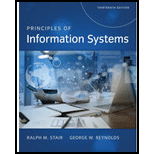
Principles of Information Systems, Loose-Leaf Version
13th Edition
ISBN: 9781305971820
Author: Ralph Stair, George Reynolds
Publisher: Course Technology
expand_more
expand_more
format_list_bulleted
Textbook Question
Chapter 5.1, Problem 2RQ
Which attribute would you designate as the primary key?
Expert Solution & Answer
Want to see the full answer?
Check out a sample textbook solution
Students have asked these similar questions
What is the meaning of the primary key?
What is candidate key?
Explain the role of a primary key.
Chapter 5 Solutions
Principles of Information Systems, Loose-Leaf Version
Ch. 5.1 - Prob. 1RQCh. 5.1 - Which attribute would you designate as the primary...Ch. 5.1 - Prob. 1CTQCh. 5.1 - Prob. 2CTQCh. 5.2 - Prob. 1RQCh. 5.2 - Prob. 2RQCh. 5.2 - Prob. 1CTQCh. 5.2 - Prob. 2CTQCh. 5.3 - Prob. 1RQCh. 5.3 - Prob. 2RQ
Ch. 5.3 - What additional questions need to be answered...Ch. 5.3 - Prob. 2CTQCh. 5.4 - Prob. 1RQCh. 5.4 - Telefonica Brasil is one of the largest...Ch. 5.4 - Prob. 1CTQCh. 5.4 - Prob. 2CTQCh. 5.5 - Prob. 1RQCh. 5.5 - Prob. 2RQCh. 5.5 - Why is it unlikely that a traditional SQL database...Ch. 5.5 - Prob. 2CTQCh. 5 - Prob. 1SATCh. 5 - Prob. 2SATCh. 5 - Prob. 3SATCh. 5 - The ______________ model is a simple but highly...Ch. 5 - The ability to combine two or more tables through...Ch. 5 - Prob. 6SATCh. 5 - Prob. 7SATCh. 5 - Prob. 8SATCh. 5 - Prob. 9SATCh. 5 - Prob. 10SATCh. 5 - Prob. 11SATCh. 5 - Prob. 12SATCh. 5 - Prob. 13SATCh. 5 - Prob. 14SATCh. 5 - Prob. 15SATCh. 5 - Prob. 16SATCh. 5 - Prob. 1RQCh. 5 - In the hierarchy of data, what is the difference...Ch. 5 - Prob. 3RQCh. 5 - What is meant by data archiving? Why is this an...Ch. 5 - What is an entity-relationship diagram, and what...Ch. 5 - Identify four basic data manipulations performed...Ch. 5 - Prob. 7RQCh. 5 - Prob. 8RQCh. 5 - Prob. 9RQCh. 5 - Prob. 10RQCh. 5 - Prob. 11RQCh. 5 - Prob. 12RQCh. 5 - Prob. 13RQCh. 5 - Prob. 14RQCh. 5 - Prob. 15RQCh. 5 - Prob. 16RQCh. 5 - Prob. 17RQCh. 5 - Prob. 1DQCh. 5 - Outline some specific steps an organization might...Ch. 5 - SQL databases conform to ACID properties. Briefly...Ch. 5 - Prob. 4DQCh. 5 - Prob. 6DQCh. 5 - Prob. 8DQCh. 5 - Prob. 1PSECh. 5 - Describe the role of a database administrator....Ch. 5 - Prob. 2CECh. 5 - Prob. 1CTQ1Ch. 5 - Prob. 2CTQ1Ch. 5 - Prob. 3CTQ1Ch. 5 - Prob. 1CTQ2Ch. 5 - Prob. 2CTQ2Ch. 5 - Prob. 3CTQ2
Knowledge Booster
Learn more about
Need a deep-dive on the concept behind this application? Look no further. Learn more about this topic, computer-science and related others by exploring similar questions and additional content below.Similar questions
- A Bank has many customers. Attribute for customer includes customer number, name, address (street, city, state and zip code), sex and date of birth. Customer can have multiple accounts. The bank does not allow join account (one account per customer). Type of account offer by the bank are Saving, Current and Fixed Deposit. Attribute for account are account no, account type, and account balance. Each of the account can only exist in a particular branch. Attribute for branch are branch no, branch name and address (street, city, state and zip code). Customer can open different account at different branch. Draw an ER diagram for the above situation. Identify the entity, attributes, primary key, relationship and multiplicity constraint in the ER diagram.arrow_forwardWhy it is recommended to specify a unique index for each primary key.arrow_forwardSQL DML/DDL There are five tables describing employees of a company, departments, buildings, which department(s) an employee works in (and a percentage of the time for each), and in which building an employee works (an employee may have more than one office). The primary key of each table is the attribute(s) in capitals and underlined. The foreign keys are in italics. Other attributes are not necessarily unique.Employee (EID, Ename, Salary, Start_Date, End_Date)Building (BID, Bname, Address)Department (DID, Dname, Annual_Budget)In_Department (EID, DID, Percentage_Time)In_Building (EID, BID)Write the SQL statements for the following.1. Find the names of Departments where NO employees work. 2. For employees who are still working in the company, end date has no value (empty). For those who have left the company and have end date values, show their names and the duration of their employment in years. 3. Find the names of buildings where more than 50 employees work. 4. The tables have…arrow_forward
- Please describe the three unique data types, as well as the method through which they were acquired?arrow_forwardThe following fields are presented in the table: Member Last Name, MemberFirstName, Street, City, State, ZipCode and MemberFee. The table contains 75,000 documents. How would you build indexes for the table and why would you create these indexes?arrow_forwardexplain the function of the FOREIGN KEY definition.arrow_forward
arrow_back_ios
SEE MORE QUESTIONS
arrow_forward_ios
Recommended textbooks for you
 Principles of Information Systems (MindTap Course...Computer ScienceISBN:9781305971776Author:Ralph Stair, George ReynoldsPublisher:Cengage Learning
Principles of Information Systems (MindTap Course...Computer ScienceISBN:9781305971776Author:Ralph Stair, George ReynoldsPublisher:Cengage Learning Fundamentals of Information SystemsComputer ScienceISBN:9781337097536Author:Ralph Stair, George ReynoldsPublisher:Cengage Learning
Fundamentals of Information SystemsComputer ScienceISBN:9781337097536Author:Ralph Stair, George ReynoldsPublisher:Cengage Learning
 Programming with Microsoft Visual Basic 2017Computer ScienceISBN:9781337102124Author:Diane ZakPublisher:Cengage Learning
Programming with Microsoft Visual Basic 2017Computer ScienceISBN:9781337102124Author:Diane ZakPublisher:Cengage Learning A Guide to SQLComputer ScienceISBN:9781111527273Author:Philip J. PrattPublisher:Course Technology Ptr
A Guide to SQLComputer ScienceISBN:9781111527273Author:Philip J. PrattPublisher:Course Technology Ptr

Principles of Information Systems (MindTap Course...
Computer Science
ISBN:9781305971776
Author:Ralph Stair, George Reynolds
Publisher:Cengage Learning

Fundamentals of Information Systems
Computer Science
ISBN:9781337097536
Author:Ralph Stair, George Reynolds
Publisher:Cengage Learning


Programming with Microsoft Visual Basic 2017
Computer Science
ISBN:9781337102124
Author:Diane Zak
Publisher:Cengage Learning


A Guide to SQL
Computer Science
ISBN:9781111527273
Author:Philip J. Pratt
Publisher:Course Technology Ptr
How to Design DB Tables for any Application? (The Basics); Author: Studytonight;https://www.youtube.com/watch?v=XUdNVaSikqY;License: Standard YouTube License, CC-BY
Create a Table (Introduction to Oracle SQL); Author: Database Star;https://www.youtube.com/watch?v=BiV1IrzB1sY;License: Standard Youtube License